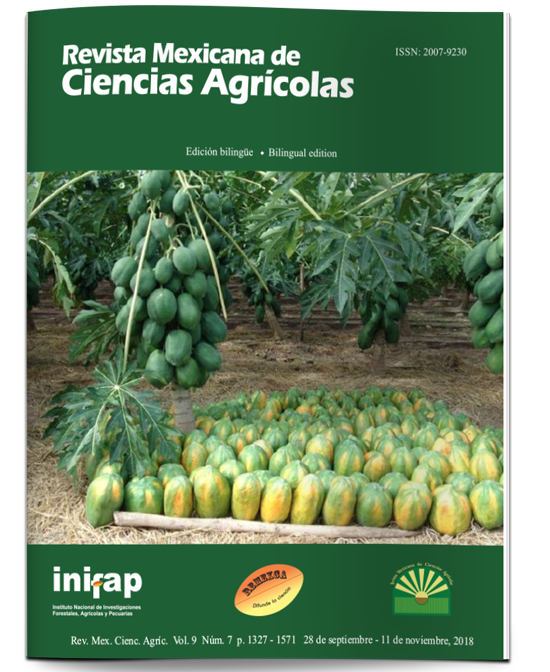In vitro effect of potassium phosphite on Athelia rolfsii and Pythium aphanidermatum
DOI:
https://doi.org/10.29312/remexca.v9i7.286Keywords:
biomass production, mycelial growth, oospore formation, sclerotia formationAbstract
The objective of this study was to determine the in vitro effect of potassium phosphite on the radial growth of the mycelium, the production of biomass and the production of sclerotia of Athelia rolfsii and oospores of Pythium aphanidermatum. Doses of 0.05, 0.1, 0.15, 0.2, 0.25 and 0.3 mL L-1 of potassium phosphite and an absolute control (without potassium phosphite) were evaluated using PDA culture medium and distilled water. The radial growth of mycelium decreased due to potassium phosphite, so at the end of the evaluation and comparing it with the control, the radial growth of P. aphanidermatum decreased from 16.9 to 53.2% and from 15 to 21.3% for A. rolfsii. At 96 h after sowing, biomass production by P. aphanidermatum and A. rolfsii decreased from 16.9 to 53.2% and 58.3 to 63.4%, respectively. After 72 h of sowing, the formation of oospores of P. aphanidermatum on distilled water with potassium phosphite was not observed, which did occur in the control after 24 h. At 22 days after sowing, A. rolfsii produced an average of 30.2 sclerotia, whereas in PDA with potassium phosphite it did not form sclerotia. This indicates that potassium phosphite is an effective substance to reduce mycelial growth, the production of biomass, and inhibits the formation of oospores of P. aphanidermatum and of sclerotia of A. rolfsii.
Downloads
Downloads
Published
How to Cite
Issue
Section
License
The authors who publish in Revista Mexicana de Ciencias Agrícolas accept the following conditions:
In accordance with copyright laws, Revista Mexicana de Ciencias Agrícolas recognizes and respects the authors’ moral right and ownership of property rights which will be transferred to the journal for dissemination in open access. Invariably, all the authors have to sign a letter of transfer of property rights and of originality of the article to Instituto Nacional de Investigaciones Forestales, Agrícolas y Pecuarias (INIFAP) [National Institute of Forestry, Agricultural and Livestock Research]. The author(s) must pay a fee for the reception of articles before proceeding to editorial review.
All the texts published by Revista Mexicana de Ciencias Agrícolas —with no exception— are distributed under a Creative Commons License Attribution-NonCommercial 4.0 International (CC BY-NC 4.0), which allows third parties to use the publication as long as the work’s authorship and its first publication in this journal are mentioned.
The author(s) can enter into independent and additional contractual agreements for the nonexclusive distribution of the version of the article published in Revista Mexicana de Ciencias Agrícolas (for example include it into an institutional repository or publish it in a book) as long as it is clearly and explicitly indicated that the work was published for the first time in Revista Mexicana de Ciencias Agrícolas.
For all the above, the authors shall send the Letter-transfer of Property Rights for the first publication duly filled in and signed by the author(s). This form must be sent as a PDF file to: revista_atm@yahoo.com.mx; cienciasagricola@inifap.gob.mx; remexca2017@gmail.
This work is licensed under a Creative Commons Attribution-Noncommercial 4.0 International license.



